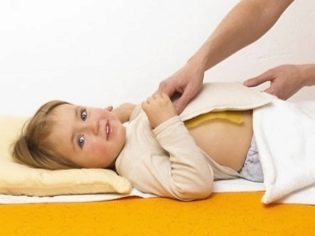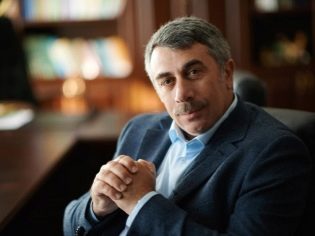Massage for bronchitis in children
Respiratory diseases in children are very common, because the immunity of babies is not mature enough, and some structural features of the respiratory system predispose to inflammatory processes. Many parents have heard that at the final stage, when the acute period is left behind, the so-called drainage percussion massage helps children well. How to carry it to a child, you will learn from this material.
Purpose and benefit
Massage for bronchitis has a number of important goals - to improve blood circulation and increase blood flow to the respiratory organs, to increase their local immunity. But the main goal - the liberation of the bronchi from the remnants of mucus - bronchial secretions. With the disease, this mucus is formed in large quantities and partially disappears during cough - this is the so-called phlegm in the people.
The risk of respiratory diseases in general and bronchitis in particular lies in the fact that bronchial mucus can dry up or become too thick, and its discharge will become difficult. Pathogenic microorganisms in a stagnant medium will begin to multiply at an unprecedented rate, since this medium is most favorable for them. As a result, bronchitis will have a severe and prolonged course, and may also turn into pneumonia.
Special therapeutic and therapeutic massage is designed to prevent such consequences. It is needed for the discharge of sputum, for the release of the bronchi and a speedy recovery without complications. Sessions are permissible for children of any age - both infants and schoolchildren. Children's vibration massage is easy to learn, it is easily carried out at home. Any special medical skills such sessions from the parents does not require.
The benefit of such an effect is obvious - cough is improved, breathing improves, the blood supply to the lungs increases, the lymph flows more efficiently, the child feels better and is recovering much faster.
Types of exposure
The best massage for bronchitis is a combined, which includes elements of drainage, vibration and point effects. Drainage effects contribute to the main goal - the release of respiratory tract from mucus. In fact, it is massaging the back and chest in a position in which the baby’s head is below the level of its priests. Vibration impact involves tapping different intensity in different parts of the chest and upper back. Acupressure is the effect on certain bioactive points that in the human body are responsible for the state of the organs of the respiratory system.
Some supplement the massage program with cans. Canned massage in children is a moot point, many pediatricians today advise categorically to abandon it, in any case, to avoid such an impact in carrying out procedures for children under one year old.
Honey massage of the chest, which also shows itself to be quite an effective measure for bronchitis, is not recommended for children under 3 years old, since beekeeping products and honey are very allergenic and cough can only increase, as the main reason for this is the respiratory and contact allergic reaction honey.
Honey rubbing with obstructive bronchitis should be especially avoided.
Performance technique
Begin the massage from the back.Lay the child on your lap on a pillow so that the head of the child is below the level of the priests. To do this, one sitting mother can put a small ottoman under one leg. A child of school age must be laid on the belly across the bed, offering to hang his head out of bed and put a pillow under the basin.
The drainage part of the massage on the back is performed as follows:
- use two hands to “draw” with a slight wave pressure from bottom to top on the right and left of the spine, avoid pressure on the vertebrae;
- palm rubbing long back muscles from the bottom up, drawing straight lines to the right and left of the spinal column;
- “Draw” with pressure transverse lines in the right and left sides of the spine to the ribs;
- put it on the ribs on the right and then on the left palm and lightly press it on top with the fingers of your other hand.
Sit the child (if it is a chest baby, lift it upright and attach the tummy to it) and lightly tap the finger tips on the back and ribs so that the baby clears his throat. Go to the massage of the chest. It runs like this:
- place the child on his back so that the head is still below the pelvis level;
- open palms easily rub the chest in the direction from the center to the ribs;
- rubbing with gentle pressure from the center of the chest up to the shoulders and collarbone;
- Knock out the intercostal space in the center of the chest and on the sides with your fingertips.
Put the child in a sitting position, ask him to stretch his arms forward, lean slightly (just put the baby in an upright position) and cough.
General recommendations
Massage for bronchitis is not recommended if the child has a fever. Usually at 4-5 days the condition stabilizes. As soon as the temperature returns to normal, you can begin to do this massage.
Avoid sessions with respiratory complications, such as tracheobronchitis, because tracheitis can create an obstacle to the discharge of mucus.
You can massage the child several times a day, the duration of each session is from 5 to 10 minutes. It depends on age and well-being. If the child quickly gets tired, begins to act up, massage should be stopped, let the child cough up and return to the massage next time.
Do not massage immediately before bedtime, since the nervous system of the baby may become overexcited and it will be difficult for him to fall asleep.
Opinion of Dr. Komarovsky
Renowned pediatrician and TV presenter Yevgeny Komarovsky claims that massage for bronchitis is a great way to help a child cope with an illness. Given that some children manage to get bronchitis 5-8 times a year, the ability to make a special massage is a big plus for caring parents.
In order for the massage to bring maximum benefit, Evgeny O. recommends maintaining the right conditions in the house under which drying of bronchial mucus becomes unlikely - the air temperature at 21 degrees and the relative humidity of air at 50-70%.
To complete a massage session at home for large children, the doctor recommends breathing exercises with the elements - put the child on his knees, tilt the body slightly forward, hang his hands forward. On the “one” account, a deep breath is taken, and on the “two” - an exhalation with a strong cough.
But from inhalation with bronchitis, especially with obstructive, the doctor warns - the effect of steam increases the amount of sputum, and withdraw it will be much more difficult. Well, if parents so want the child to breathe medicine, you can use with caution not a regular inhaler, but a special device — a nebulizer. Naturally, with the permission of the doctor.
Komarovsky reminds that mother should do massage with clean hands. For drainage and vibration effects, emollients like butter or baby cream are not required. The nails on the hands of the masseur should be cut short, the fingers should not be rings, and on the wrist - bracelets and watches.
Before you begin to massage the child for bronchitis, Komarovsky strongly recommends consulting with your doctor to avoid possible contraindications and danger.
Learn more about how to do massage for children with bronchitis, you will learn from the following video.



















